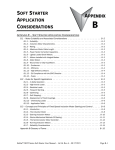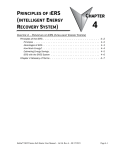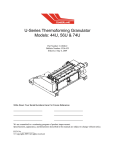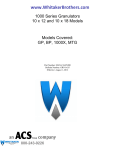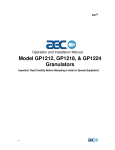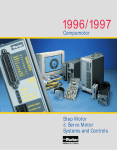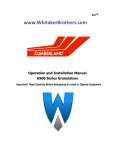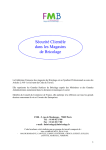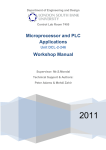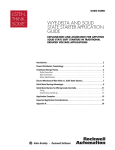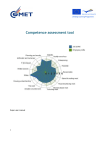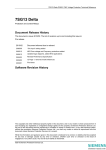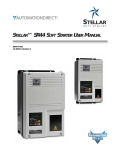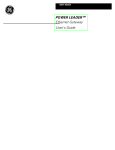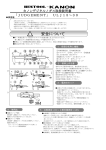Download Chapter 3 - AutomationDirect
Transcript
CHAPTER 3 APPLICATIONS Contents of this Chapter... 3.1 – Motor Suitability and Associated Considerations . . . .3–2 3.1.1 – Suitability . . . . . . . . . . . . . . . . . . . . . . . . . . . . . . . . . . . . . . . . . . . . .3–2 3.1.2 – Induction Motor Characteristics . . . . . . . . . . . . . . . . . . . . . . . . . . . .3–2 3.1.3 – Rating . . . . . . . . . . . . . . . . . . . . . . . . . . . . . . . . . . . . . . . . . . . . . . . .3–2 3.1.4 – Maximum Motor Cable Length . . . . . . . . . . . . . . . . . . . . . . . . . . . . .3–3 3.1.5 – Power Factor Correction Capacitors . . . . . . . . . . . . . . . . . . . . . . . . .3–3 3.1.6 – Lightly Loaded Small Motors . . . . . . . . . . . . . . . . . . . . . . . . . . . . . . .3–3 3.1.7 – Motors Installed with Integral Brakes . . . . . . . . . . . . . . . . . . . . . . . .3–3 3.1.8 – Older Motors . . . . . . . . . . . . . . . . . . . . . . . . . . . . . . . . . . . . . . . . . .3–3 3.1.9 – Wound-rotor or Slip-ring Motors . . . . . . . . . . . . . . . . . . . . . . . . . . . .3–3 3.1.10 – Enclosures . . . . . . . . . . . . . . . . . . . . . . . . . . . . . . . . . . . . . . . . . . . .3–3 3.1.11 – Efficiency . . . . . . . . . . . . . . . . . . . . . . . . . . . . . . . . . . . . . . . . . . . . .3–4 3.1.12 – High-Efficiency Motors . . . . . . . . . . . . . . . . . . . . . . . . . . . . . . . . . .3–4 3.1.13 – EU Compliance with the EMC Directive . . . . . . . . . . . . . . . . . . . . .3–4 3.1.14 – Fuses . . . . . . . . . . . . . . . . . . . . . . . . . . . . . . . . . . . . . . . . . . . . . . . .3–4 3.2 – Rules for Specific Applications . . . . . . . . . . . . . . . . . .3–5 3.2.1 – In-Delta Operation . . . . . . . . . . . . . . . . . . . . . . . . . . . . . . . . . . . . . .3–5 3.2.2 – High-Inertia Loads . . . . . . . . . . . . . . . . . . . . . . . . . . . . . . . . . . . . . . .3–5 3.2.3 – Reserved . . . . . . . . . . . . . . . . . . . . . . . . . . . . . . . . . . . . . . . . . . . . . .3–5 3.2.4 – Resistive Loads . . . . . . . . . . . . . . . . . . . . . . . . . . . . . . . . . . . . . . . . .3–5 3.2.5 – Frequent Starting . . . . . . . . . . . . . . . . . . . . . . . . . . . . . . . . . . . . . . .3–5 3.2.6 – Optimizing . . . . . . . . . . . . . . . . . . . . . . . . . . . . . . . . . . . . . . . . . . . .3–5 3.2.7 – Soft Stopping . . . . . . . . . . . . . . . . . . . . . . . . . . . . . . . . . . . . . . . . . .3–6 3.2.8 – Reversing Drives and Plug-braking . . . . . . . . . . . . . . . . . . . . . . . . . .3–6 3.2.9 – Replacement of Fluid Couplings . . . . . . . . . . . . . . . . . . . . . . . . . . . .3–6 3.2.10 – Two-speed Motor Applications . . . . . . . . . . . . . . . . . . . . . . . . . . . .3–6 3.2.11 – Multiple Motor Starting . . . . . . . . . . . . . . . . . . . . . . . . . . . . . . . . .3–6 3.2.12 – Overhauling Loads . . . . . . . . . . . . . . . . . . . . . . . . . . . . . . . . . . . . .3–6 3.2.13 – Application Table . . . . . . . . . . . . . . . . . . . . . . . . . . . . . . . . . . . . . .3–6 (Table of Contents continued next page) 3–1a CHAPTER 3 APPLICATIONS (Table of Contents continued from previous page) 3.3 – Concepts and Principles of Fixed-Speed Induction Motor Starting and Control . . . . . . . . . . . .3–8 3.3.1 3.3.2 3.3.3 3.3.4 3.3.5 3.3.6 3.3.7 – – – – – – – Introduction . . . . . . . . . . . . . . . . . . . . . . . . . . . . . . . . . . . . . . . . . . .3–8 The Induction Motor . . . . . . . . . . . . . . . . . . . . . . . . . . . . . . . . . . . . .3–8 Starting Induction Motors . . . . . . . . . . . . . . . . . . . . . . . . . . . . . . . .3–10 Electro-Mechanical Methods Of Starting . . . . . . . . . . . . . . . . . . . . .3–11 The Semiconductor Motor Controller . . . . . . . . . . . . . . . . . . . . . . .3–12 Running Induction Motors . . . . . . . . . . . . . . . . . . . . . . . . . . . . . . .3–13 Reliability Considerations . . . . . . . . . . . . . . . . . . . . . . . . . . . . . . . .3–14 3.4 – Principles of the Optimizing Mode . . . . . . . . . . . . . .3–15 3.4.1 3.4.2 3.4.3 3.4.4 3.4.5 3.4.6 – – – – – – Principles . . . . . . . . . . . . . . . . . . . . . . . . . . . . . . . . . . . . . . . . . . . .3–15 Advantages of Energy Optimizing . . . . . . . . . . . . . . . . . . . . . . . . . .3–16 Additional Benefits in Practice . . . . . . . . . . . . . . . . . . . . . . . . . . . . .3–16 Optimizing with the SR44 System . . . . . . . . . . . . . . . . . . . . . . . . . .3–17 How Much Energy? . . . . . . . . . . . . . . . . . . . . . . . . . . . . . . . . . . . .3–18 Estimating Energy Savings . . . . . . . . . . . . . . . . . . . . . . . . . . . . . . .3–19 3.5 – Chapter 3 Glossary of Terms . . . . . . . . . . . . . . . . . .3–20 3.6 – Power Factor Conversion Chart . . . . . . . . . . . . . . . .3–21 3–1b CHAPTER 3 APPLICATIONS BLANK PAGE 3–1c Chapter 3: Applications 3.1 – Motor Suitability and Associated Considerations The SR44 Soft Starter is based on a series of microprocessor-based optimizing soft starters which have been used world-wide in more than 100,000 critical and non-critical systems. Since 1983, these soft starters have successfully operated with almost every type of load and environment from the Antarctic to the Jungle. The design has proven to be both reliable and adaptable, and provides a powerful mechanism with which to control fixed-speed induction motors. However, due to the intrinsic differences between electronic and electro-mechanical starting systems, there are a number of simple rules and observations to follow when using the SR44 Soft Starter. This section introduces guidelines for the user and those incorporating the unit as part of their system design. 3.1.1 – Suitability In principle, any three-phase induction motor can be started by a soft starter. Normally, the breakaway torque of the load should be less than the full-load torque of the motor, unless a motor with a high locked-rotor torque characteristic is employed. As a quick assessment, any load which has a low or no-load start with a moderate starting time, or which can be started with a star-delta (wye-delta) starter, auto transformer or other forms of reduced-voltage starting, can be considered a potential application for a soft starter. 3.1.2 – Induction Motor Characteristics Three-phase induction motors are required to provide sufficient torque to accelerate the motor and its load from standstill to full speed, and to maintain full speed efficiently at all torque levels up to the design full-load torque. Most modern three-phase induction motors have characteristics that are wholly suitable for use with soft starters. However, the characteristics vary considerably between different manufacturers and design types. It is important that the motor is capable of providing sufficient torque to drive the load at all speeds from standstill to rated speed, to enable the SR44 to function properly. It is particularly important that the motor to be soft started does not have a low pull-up or saddle torque, or the load may not be accelerated correctly. The primary function of the soft starter is to act as a torque-regulating device. It cannot apply a torque greater than that which the motor generates. For this reason, problematic applications for which many different starting methods have been tried but failed may need analysis of the motor or load performance before a soft starter can be successfully applied. 3.1.3 – Rating For most applications, except high inertia loads, the starting demands and the inertia of the rotating masses are small enough to be insignificant. This means that no special consideration needs to be given to the rating of the soft starter, other than to ensure that it is equal or marginally greater than the rated voltage and current of the controlled motor. Alternatively, if the number of poles of the motor and the moments of inertia of the load (Jload) and motor rotor (Jmotor) are known, a soft starter will be suitable if the figures comply with the criteria given in the bottom row of Table 3.1.3. Table 3.1.3 Number of Poles 2 4 6 8 Synchronous Speed (rpm @ 60 Hz) (Jload)/(Jmotor) less than 3600 1800 1200 900 5 15 20 25 Section 3.2.13 contains a table showing the more common applications. 3–2 SR44 Series Soft Starter User Manual 1st Ed, Rev A 09/2011 Chapter 3: Applications 3.1.4 – Maximum Motor Cable Length The length of the cable between the output terminals of the starter and the motor should not normally be greater than 100 meters [328 ft]. 3.1.5 – Power Factor Correction Capacitors Power factor correction capacitors applied to a single motor must ALWAYS be connected by a separate contactor placed on the SUPPLY side of the SR44 Soft Starter. Capacitors should be switched into the circuit after top-of-ramp (full line voltage) is reached, and switched out of the circuit before a stop is initiated. It is important that any total system PFC scheme that automatically corrects for a range of inductive loads is not operated in such a way as to leave it heavily over compensated since this might introduce oscillations leading to damaging over-voltages. 3.1.6 – Lightly Loaded Small Motors Lightly loaded small-sized (less than 2kW [2.7 hp]), star connected motors can produce high voltages at the motor terminals when shut down by simply opening the line contactor. As these voltages can damage the soft starter, it is safer to control the opening of the line contactor with the soft starter run relay contacts. 3.1.7 – Motors Installed with Integral Brakes Motors that include an integral, electrically operated brake internally connected to the motor input terminals can only be soft started when the brake is re-connected to the supply through its own contactor. (Do NOT soft start the brake.) 3.1.8 – Older Motors The action of the fully-controlled soft starter introduces harmonic currents and voltages to the motor. Therefore, it is important to ensure that the motor employs techniques such as rotor skewing in its construction to suppress the effects of harmonic fluxes and avoid rough starting. This is rarely a problem with modern motors, because nearly all motors designed in the last 20 years employ these techniques. 3.1.9 – Wound-rotor or Slip-ring Motors Slip-ring induction motors ALWAYS need some resistance in the rotor circuit to ensure that sufficient rotational torque is generated to overcome any alignment torque, which is present at start-up. The resistance can be safely shorted out in the normal fashion with a contactor controlled by the programmable relay set as ‘top-of-ramp’ contacts. 3.1.10 – Enclosures Thyristors are not perfect conductors, and the passage of current through them causes heat dissipation in the body of the soft starter, which in turn causes the heatsink temperature to increase. As a guide, the heat generated is 1 watt/amp/phase, which equates to a dissipation of 30 watts from the heatsink for a line current of 10 amps. Therefore, all cabinets or enclosures that house soft starters should have adequate ventilation. (Refer to the Mechanical Installation procedures, sections 1.6 to 1.8 for more detailed information.) 1st Ed, Rev A 09/2011 SR44 Series Soft Starter User Manual 3–3 Chapter 3: Applications 3.1.11 – Efficiency Although the use of the soft starter introduces a power loss, the system still retains an overall efficiency of approximately 99.5%. If the optimizing function is selected, then the gain in motor efficiency at partial loads is far greater than the loss of efficiency arising from thyristor heat losses. If prolonged operation at full load is expected, the thyristor loss can be eliminated (as in some matched motor/pump drives) by closing a bypass contactor around the soft starter. (This contactor is readily controlled by the programmable relay set as ‘top-of-ramp’ contacts as the circuit in section 2.4.1 shows.) 3.1.12 – High-Efficiency Motors Due to an inherently steep front to the speed/torque curve, high-efficiency motors can exhibit instability when lightly loaded, and the optimizing rate parameter P19 may need to be adjusted to compensate. 3.1.13 – EU Compliance with the EMC Directive When considering the use or fitting of any Soft Starter, users and installers in European countries must comply with the EMC Directive 89/336/EEC. The manufacturer of the soft starter has a statutory obligation to provide a guide for compliance with this directive. For the SR44, this guidance is given in the EMC guide which is chapter 4 of this manual. It is essential that users and installers understand and comply with the requirements described in these sections. 3.1.14 – Fuses Circuit protection fuses should be rated to allow for the extended start times associated with the use of a Soft Starter. Traditional HRC motor fuses may need to be rated higher than the motor rated current for normal low-inertia applications, but modern “extended start” fuses will generally give full motor protection. (See also section 3.2.2 relating to high inertia loads.) Semiconductor fuses are available for the short-circuit protection of the thyristors in the SR44. See the “Fuse and Current Ratings” section in chapter 2 (“Electrical Installation”) of this manual for semiconductor fuse recommendations and details of the Overload incorporated into the SR44. 3–4 SR44 Series Soft Starter User Manual 1st Ed, Rev A 09/2011 Chapter 3: Applications 3.2 – Rules for Specific Applications 3.2.1 – In-Delta Operation The SR44 control system allows the soft starter to be installed “in the delta” connections of the motor, which can permit the use of a lower current rated unit. However, in this mode of operation it is important that the soft starter is connected in accordance with the relevant wiring diagram. The connection diagram in Figure 2.3.2 of the Electrical Installation chapter gives detailed instructions for this configuration. If motor rotation is incorrect, the connections should be changed as detailed in Figure 2.3.2. It should be noted that six connections are required between the motor and soft starter. Parameter P6 must be set to 1 for delta mode, which also disables optimizing. An in-line isolation contactor controlled by the soft starter MUST be used with the InDelta Firing Mode and motor connections. 3.2.2 – High-Inertia Loads High-inertia loads, such as centrifugal and axial fans, grinders, flywheel presses, etc., may require a larger size soft starter than the motor. For example, a 75kW [100 hp] starter may be needed for a 55kW [75 hp] motor. This is necessary to allow for the extra heating effects of the prolonged over-current on the soft starter thyristors during the extended starting time. If very high-inertia loads are involved, then an analysis of the starting characteristics should be made. This requires accurate data about the motor and the load: • Complete motor data: Current, Voltage, Power, Speed, Rotor Inertia, Speed/Torque/Current curves • Complete load data: Type of load, Speed, Inertia, Speed/Torque curve, Power absorbed or Full-load Torque Consideration must also be given to thermal overload and fuse protection systems when extended start times are involved. This is the case for heavy duty starting, as a standard thermal overload will trip under these conditions. A heavy-duty start thermal overload or an electronic overload with dual settings for start and run is recommended. Modern HRC motor fuses will allow for some overload during the start, but the fuse curve, giving time/current data, will give an indication of suitability for the particular application. 3.2.3 – Reserved 3.2.4 – Resistive Loads AutomationDirect does not support the control of resistive loads with the SR44 Soft Starter. 3.2.5 – Frequent Starting High starting frequencies require careful consideration of the soft starter thermal capabilities. In many cases a standard sized SR44 may be suitable, as start times are generally shorter for this type of application. If this is not the case, then a larger soft starter may be required. 3.2.6 – Optimizing Drives which operate for long periods of time at less than their rated capacity can benefit from the energy saving function (optimizing) of the SR44, which adjusts the thyristor triggering to reduce the excitation losses of the motor. This feature will lower the running temperature of the machine and help to extend its life. See Section 3.4, Principles of the Optimizing Mode. 1st Ed, Rev A 09/2011 SR44 Series Soft Starter User Manual 3–5 Chapter 3: Applications 3.2.7 – Soft Stopping Soft stopping can reduce positive surge pressures in pipelines on shutdown. It is necessary to make sure that the ramp-down time is long enough to remove the energy from the fluid before the firing of the thyristors is stopped. Otherwise the surge pressure may still be present. Soft stopping can also be successfully applied to loads such as conveyer belt systems where sensitive items such as bottles are being transported. 3.2.8 – Reversing Drives and Plug-braking SR44 Soft Starters used in conjunction with contactor controlled reversing and plug-braked motors show considerable benefits to the user by reducing mechanical and electrical stresses, particularly when utilizing the current limited start feature. This type of application requires inserting a 150–350 ms delay between the opening of one contactor and the closing of the other, to allow any residual flux in the rotor to die away. When plug-braking, there should be some form of zerospeed detection to stop the drive after braking has been completed, otherwise the drive may either accelerate the motor in the reverse direction, or switch off before zero speed has been reached. The SR44 has a dual parameter setting feature which is particularly useful in plug-braking, where the braking settings need to be different from the normal starting ramp time and current limit level. See section 2.4.4 and Figure 2.4.6 of the Electrical Installation chapter for details. 3.2.9 – Replacement of Fluid Couplings Soft-starters can replace fluid couplings yielding benefits of higher efficiency running and lower costs to the user. If the coupling is used to magnify the available breakaway torque, it may be necessary to replace the installed motor with another of a larger size, or one with a high starting torque characteristic before a soft starter can be employed. 3.2.10 – Two-speed Motor Applications Two-speed motors, whether Dahlander-connected or with dual windings, can be soft-started at each speed, provided that the start is initiated when the actual motor speed is less than the synchronous speed for the winding selected. This is particularly important when changing from high to low speeds. The SR44 has a dual setting feature, which allows different operating settings for the high and low speeds, and the ability to switch rapidly between them. 3.2.11 – Multiple Motor Starting See section 2.4.2 of the Electrical Installation chapter for details. 3.2.12 – Overhauling Loads Certain applications can overspeed the motor as part of normal operation. Power then flows from the motor to the power supply. It is important to disable Optimizing Mode during over-speed conditions, and reinstate Optimizing during normal conditions. (External control is required to disable and reinstate Optimizing Mode.) 3.2.13 – Application Table The table on the following page shows many common motor applications that suit the SR44 Soft Starter. It lists typical breakaway torque requirements as a percentage of motor full-load torque (FLT). For the most satisfactory soft starter in a given application, the motor should have a fullvoltage locked-rotor-torque (LRT) that is at least twice the breakaway torque (e.g. for a reciprocating compressor the FLT is normally in the region of 50% motor LRT.) As a general rule, the higher the motor LRT is above the load breakaway torque, the greater the control over the starting process. 3–6 SR44 Series Soft Starter User Manual 1st Ed, Rev A 09/2011 Chapter 3: Applications Table 3.2.13 – Applications Application Breakaway Remarks Torque (%FLT) Agitator 35 Air compressor- rotary, unloaded start 25–35 Air compressor- reciprocating, unloaded start 50–100 Air compressor- screw type, unloaded start 30 Usually two-pole motor Ball mill 30–50 Eccentric load, needs high starting torque motor Carding machine 100 Often high inertia Centrifuge 50–90 Usually high inertia Centrifugal fan- dampers closed 10–25 Usually high inertia Centrifugal fan- dampers open 10–25 Usually high inertia, very long ramp times Centrifugal blower- valve closed 25–35 Centrifugal blower- valve open 30–40 Can have long ramp time Chillers 10–25 Usually started unloaded, two-pole motor Conveyor- horizontal, unloaded 10–50 Conveyor- horizontal, loaded 100–150 Conveyor- vertical lifting, unloaded 50–85 Conveyor- vertical lifting, loaded 100–175 Conveyor- vertical lowering, unloaded 10–40 Conveyor- vertical lowering, loaded 10–25 Crusher (not rock)- unloaded 25–75 Drilling machine- unloaded 10 Escalator- unloaded 25–50 Fan, axial-flow propeller 20–40 Feeder- screw 100–175 Needs high starting torque motor Feeder- vibrating, motor driven 100–150 Needs high starting torque motor Grinder- unloaded 10–25 Usually high inertia Hammer mill 20–125 Eccentric load, needs high starting torque motor Mills- flour etc. 30–50 Mixer- dry contents 35–75 Mixer- fluid contents 10–40 Mixer- plastic contents 75–125 High torque motor offers advantage Mixer- powder contents 75–125 High torque motor offers advantage Pelletizers 50–100 Press, flywheel 50–150 Needs high starting torque motor Pump- centrifugal 10–25 Soft stopping useful Pump- positive displacement, piston type 100–175 Needs high starting torque motor Pump- vane type, positive displacement 100–150 Needs high starting torque motor Rolling mill 30–50 Saw, band 10–35 Saw, circular 25–50 Screen, vibrating 30–60 Travelators, walkways 25 Unloaded starting Transformers, voltage regulators Nil Change firing mode Tumblers 30–100 Can be eccentric load, may need high torque motor 1st Ed, Rev A 09/2011 Can be high inertia Optimizing feature can be effective May be high inertia; Plug brake may be useful SR44 Series Soft Starter User Manual 3–7 Chapter 3: Applications 3.3 – Concepts and Principles of Fixed-Speed Induction Motor Starting and Control Since its invention one hundred years ago, the standard three-phase induction motor has become one of the most familiar items of industrial equipment ever known. Due to its simplicity of construction, low cost, reliability, and relatively high efficiency, it is likely to remain the prime source of mechanical energy for the foreseeable future. 3.3.1 – Introduction Energy conversion, from the electrical supply to rotating mechanical energy, is a characteristic of all motors. To regulate energy flow, most motor circuits require a mechanism to connect and disconnect them from their electrical power source. Electro-mechanical switches, known as “contactors”, are the standard means of achieving this control. Even today, more than one hundred years after their introduction, contactor-based systems remain the most widely used method of motor control. Nevertheless, there is a definite trend towards more sophisticated electronic systems of control being applied to fixed-speed motor drives. This section will discuss these forms of control; namely electronic microprocessor-controlled optimizing soft starters such as the SR44. 3.3.2 – The Induction Motor In order to appreciate the benefits of using an electronic controller, it is important to have some understanding of the characteristics and limitations of the induction motor and the electromechanical systems currently used to control them. The standard, fixed-speed induction motor fulfils two basic requirements: • To accelerate itself and its load to full speed (or speeds with multi-speed motors). • To maintain the load at full speed efficiently and effectively over the full range of loadings. Due to the constraints of materials and design, it can be difficult to achieve both objectives effectively and economically in one machine. So, how does a motor start in the first place? As mentioned previously, motors convert electrical energy drawn from the power supply into a mechanical form, usually as a shaft rotating at a speed fixed by the frequency of the supply. The power available from the shaft is equal to the torque (moment) multiplied by the shaft speed (rpm). From an initial value at standstill, the torque varies, up or down, as the machine accelerates until reaching a peak at about two thirds of full speed, and then dropping to zero at synchronous speed. This characteristic means that induction motors always run at slightly less than synchronous speed in order to develop power (the ‘slip speed’), and hence the term asynchronous. Figure 3.3.2.1 shows a graph is of an induction motor torque/speed curve, and illustrates this important characteristic of asynchronous three-phase induction motors. 3–8 SR44 Series Soft Starter User Manual 1st Ed, Rev A 09/2011 Chapter 3: Applications Figure 3.3.2.1: Torque/Speed Curve – Induction Motor Pull Out Torque ( MK ) TORQUE Locked Rotor Torque ( LRT, MA ) Pull-up Torque Full Load Torque ( FLT, MA ) Synchronous speed 0 SPEED Figure 3.3.2.1 Torque/Speed Curve – Induction Motor S Figure 3.3.2.2: Torque/Speed Curve – Coupled Load Each load coupled to an induction motor has its own speed/torque curve: Pull Out Torque ( MK ) TORQUE Locked Rotor Torque ( LRT, MA ) Pull-up Torque Full Load Torque ( FLT, MN ) Synchronous speed 0 SPEED Figure 3.3.2.2 Torque/Speed Curve – Coupled Load S Figure 3.3.2.3: Torque/Speed Curve – Accelerating Torque The acceleration of a motor-load system is caused by the difference between the developed torque (motor) and the absorbed torque (load), and is shown by the shaded area in the next figure: Pull Out Torque ( MK ) TORQUE Locked Rotor Torque ( LRT, MA ) Full Load Torque ( FLT, MN ) Pull-up Torque Synchronous speed 0 SPEED Figure 3.3.2.3 Torque/Speed Curve – Accelerating Torque 1st Ed, Rev A 09/2011 S SR44 Series Soft Starter User Manual 3–9 Chapter 3: Applications 3.3.2 – The Induction Motor (continued) Obviously, the larger the difference between the developed torque and the absorbed torque, the faster the acceleration and the quicker full speed is reached, and the greater the stresses experienced by the supply and drive systems during the acceleration process. An “ideal” start would accelerate the load with just sufficient force to reach full speed smoothly in a reasonable time, and with minimum stress to the supply and drive mechanisms. Generally speaking, the motor speed/torque characteristic is controlled by the rotor resistance. A motor with high rotor resistance can generate its peak torque (pull-out torque) at standstill, giving the high break-away torque characteristic which reduces steadily as the speed increases, and becomes zero at synchronous speed. At the other end of the scale, a motor with a very low rotor resistance will produce a low starting torque, but will generate its peak torque closer to the synchronous speed. Consequently, this type of motor runs at full power with higher operating efficiency and low slip speed. It is possible to combine the twin requirements of high starting torque and efficient full-speed operation within a single motor by techniques such as double-cage or deep bar design, and this usually is the motor characteristic chosen for lifting and hoisting applications: Figure 3.3.2.4: Torque/Speed Curve – High Starting Torque Pull Out Torque ( MK ) TORQUE Locked Rotor Torque ( LRT, MA ) Pull-up Torque Full Load Torque ( FLT, MN ) Synchronous speed 0 SPEED Figure 3.3.2.4 Torque/Speed Curve – High Starting Torque S However, most induction motors are designed to have a “standard” characteristic that provides a compromise between starting torque and operating efficiency. To summarize, an induction motor will only start and accelerate when it produces more torque than the connected load absorbs. This is true for all speeds, including standstill and full speed. 3.3.3 – Starting Induction Motors Starting a de-magnetized induction motor from standstill is a demanding and complex process. At the instant of switching, all the energy must be present that is necessary to magnetize the motor, to provide the acceleration force, to supply the kinetic energy of the rotor and load, and to overcome the mechanical and electrical losses. To do so at full supply voltage places considerable stresses on the supply, the motor windings, and the iron cores of the stator and rotor. Excessive acceleration of a rotor when the mechanical load is small can produce torque oscillations in the shaft, causing severe wear to transmissions, gears and drives. Excessive acceleration when the load inertia is high, such as in centrifugal fans, causes belts to slip on the pulleys, producing rapid wear and early failure. 3–10 SR44 Series Soft Starter User Manual 1st Ed, Rev A 09/2011 Chapter 3: Applications 3.3.4 – Electro-Mechanical Methods Of Starting Method A: Direct-on-Line The most simple means of controlling energy flow to an induction motor is to interrupt the power supply by a single contactor. Very widely applied, the method is known variously as “direct-online”, “across-the-line”, “direct”, etc., and is the usual form of control where low cost is the first and most important consideration. As a result, it is most often used on small motor sizes (up to approx. 22 kW [30 hp]), or where the supply is strong enough to withstand the inrush and starting current surges without causing unacceptable voltage drops. The harsh, damaging effects described earlier are all imposed by direct-on-line starting and, as a control method, it is the most destructive of equipment. Its simplicity and apparent low cost, although attractive at first sight, hide large cost penalties in the shape of increased maintenance, reduced transmission equipment life, and higher risk of motor failure, particularly when frequent starting and stopping is needed. In larger sized motors, special strengthening is necessary, at higher cost, before they can be safely used with direct-on-line starting. However, the shortcomings of the direct-on-line starter have been recognized ever since motors have been used, and alternative systems have been developed over the years to reduce the damaging effects of this form of control. Method B: Wye-Delta and other Reduced Voltage Starting Systems Reduced voltage starting makes use of the fact that motor torque is proportional to the square of the terminal voltage. The most familiar type of reduced-voltage starter is the wye-delta, or stardelta starter. Consisting of three contactors and a time switch (which can be mechanical, pneumatic, electrical, or electronic), the wye-delta starter changes the motor winding configuration from an initial wye connection to a delta connection as the motor accelerates. The change-over or transition point is controlled by the time switch and is usually arranged to be approximately at 80% of full speed. The effect of starting in the wye connection is to alter the voltage across each stator winding to 58% of normal. This reduces the starting torque to a third of locked rotor torque (LRT) with a consequent reduction in starting currents and acceleration forces. Although an apparent improvement over the direct system, significant disadvantages still remain. The transfer from wye to delta momentarily removes the motor from the supply. During this time the motor is under the mechanical influence of the rotating load and, at the instant of disconnection, current will still flow in the rotor bars due to the time delay necessary for the magnetic flux to die away. Therefore, there is a residual flux “frozen” on the surface of the rotating rotor, which cuts the stator windings, generating a voltage whose frequency depends on the rotor speed. If the load inertia is small, such as in a pump, or if the friction is high, there could be a significant loss of speed during the time the supply is disconnected. In this case, when the reconnection to delta is made, a large phase differential can exist between the supply and the rotor fluxes. This can give rise to very large current surges (as much or more than full-voltage locked rotor current), together with massive transient torque oscillations, which can peak at levels in the region of fifteen times full-load torque. Although the effects described are only present for a very short period of time (about one fifth of a second), they are sources of great stress and damage to the whole drive system, and where frequent starting is necessary, invoke high maintenance costs. The current surges, in the form of very high-level short-duration “spikes”, are an increasing problem for computer control systems and other sensitive electronic equipment. The voltage disturbance on the supply is very difficult to filter out and can cause severe problems, especially when larger motors are involved. 1st Ed, Rev A 09/2011 SR44 Series Soft Starter User Manual 3–11 Chapter 3: Applications There are methods of control, for example, the Wauchope starter, which eliminate or reduce the reconnection transients. However, such starters are expensive and have reliability implications, and they are not widely applied for these reasons. The wye-delta starter also has disadvantages due to the restricted starting torque available (if you need 40% LRT to break-away, you can only increase the motor size, or revert to direct-on-line). Combined with the severe effects of the re-switching surges, and the additional costs of bringing six conductors from the motor to the starter instead of only three; wye-delta only offers an imperfect solution to the problem of starting the induction motor. Method C: Primary Resistance Starter It has long been recognized that the transition step in the wye-delta system was a source of problems such as welded contactors, sheared drive shafts etc. For many years a method of stepless control has been available in the form of the primary resistance starter. This type of controller inserts a resistance in one, or more often in each, of the phase connections to the stator at start-up, after which it is progressively reduced and shorted out at the end of the acceleration process. Frequently, the resistances are movable blades that are gradually inserted into an electrolyte liquid. The mechanism is usually large and expensive, both to purchase and to maintain, and considerable heat is created by the passage of current through the electrolyte resistor. This limits the starting frequency (because the electrolyte has to condense back to liquid before a new start can proceed), and these restrictions prevent this starter from being a popular option when selecting a control system. However, it has the distinction of being the smoothest and least stressful method of accelerating an induction motor and its load. Method D: Other Electro-Mechanical Systems Other control methods such as auto-transformer starting (popular in North America), primary reactance starting etc., are employed to a greater or lesser extent, to compensate for some of the disadvantages of each type of starter discussed. Nevertheless, the fundamental problems of electro-mechanical starters remain, and it is only in the last decade or two that their dominance has been challenged by the introduction of power semiconductors controlled by electronics. 3.3.5 – The Semiconductor Motor Controller During the 1950s, much effort was put into the development of a four-layer transistor device which had the power to switch large currents at high voltages when triggered by a very small pulse of current. This device became known as the silicon controlled rectifier (SCR), or in Europe, the “Thyristor”, and it is the basis on which all soft starting systems are built. The characteristic of most interest is the ability of the thyristor to switch rapidly (in about 5 millionths of a second) from “OFF” to “ON” when pulsed, and to remain “ON” until the current through the device falls to zero (which conveniently happens at the end of each half-cycle in alternating current supplies). By controlling the switch-on point of a thyristor relative to the voltage zero crossing in each half wave of an alternating current, it is possible to regulate the energy passing through the device. The closer the turn-on point is to the voltage zero crossing point, the longer the energy is allowed to flow during the half-cycle. Conversely, delaying the turn-on point reduces the time for the energy to flow. Putting two thyristors back-to-back (or anti-parallel) in each of the phase connections to a motor, and by precisely controlling their turn-on points, an electronic soft starter continuously adjusts the passage of energy from the supply so that it is just sufficient for the motor to perform satisfactorily. So, for instance, by starting with a large delay to the turn on point in each half cycle, and progressively reducing it over a selected time period, the voltage applied to the motor starts from a relatively low value and increases to full voltage. Due to the motor torque being proportional to the square of the applied voltage, the starting torque follows the same pattern giving the characteristic smooth, stepless start of the soft starter. 3–12 SR44 Series Soft Starter User Manual 1st Ed, Rev A 09/2011 Chapter 3: Applications 3.3.6 – Running Induction Motors Once a start has been completed, the motor operating efficiency becomes of interest. When working at or near full load, the typical three-phase induction motor is relatively efficient, and readily achieves efficiencies of 85% to 95%. However, as shown below, motor efficiency falls dramatically when the load falls to less than 50% of rated output. Figure 3.3.6.1: Motor Efficiency/Load Characteristic 100% EFFICIENCY 0 1/2 LOAD 1/1 Figure 3.3.6.1 Motor Efficiency/Load Characteristic In fact, very few motors actually experience consistent fully rated operation, and the vast majority operate at much lower loads due to either over-sizing (a very frequent situation), or natural load variations. For Fan and Pumping applications, the affinity laws will allow the inverter drive to show very considerable energy savings over virtually all other methods of control through varying the speed of the motor in response to changes in load. Where motor speeds cannot be varied, an optimizing version of semiconductor motor controller, such as the SR44, will also produce energy savings in lightly loaded motors. Less sophisticated systems of soft starters remain at full conduction, and the motor then behaves as if it were connected directly to the main supply. However, at light loads and mains voltages, induction motors always have excess magnetic flux, and efficiency loss and power factor degradation result. By detecting the load at any instant and adjusting the motor terminal voltage accordingly, it is possible to save some of the excitation energy and load loss, and therefore improve motor power factor when the motor is running inefficiently at light loads. Figure 3.3.6.2: Motor Efficiency/Loss Characteristic LOAD LOSSES STRAY EXCITATION MECHANICAL 0 1/2 LOAD 1/1 Figure 3.3.6.2 Motor Efficiency/Loss Characteristic 1st Ed, Rev A 09/2011 SR44 Series Soft Starter User Manual 3–13 Chapter 3: Applications All SR44 Soft Starters are microprocessor controlled, and this gives them a number of advantages. Firstly, there are no adjustments to be made for the energy saving function; all calculations necessary to find the best degree of phase-back of the thyristors for any load condition is made by the microprocessor. Secondly, the start always synchronizes with the supply voltage, and a special structure of turn-on pulses virtually eliminates the inrush currents normally associated with motor start-up. This happens every time. Lastly, there is the absolutely stepless starting process, otherwise found only with primary resistance or reactance electromechanical starters – but without the wasted energy, and with the opportunity to control the maximum current allowed to flow during the starting process. Other features such as soft stopping are included to give considerable control over all modes of induction motor operation. 3.3.7 – Reliability Considerations Reliability is an aspect which is of increasing concern regarding electronic controllers for induction motors. There is little point in installing an expensive item of electronic equipment to save potentially considerable amounts of money if the device is unreliable to the point that vital processes are constantly interrupted. There are electronic products in the market place which appear to offer soft starting more cheaply. However, they almost always rely on less advantageous technologies such as analog control, or half-control, where one of the two thyristors in each phase is replaced with a diode. There are systems which only control the energy flow in one phase while the other two are directly connected. Owing to the variable quality and performance of many so-called inverters and soft starters available to the unsuspecting purchaser, international standards for these products have been developed. So far, IEC 60947-4-2 – “AC Semiconductor Motor Controllers and Starters” defines the soft starter in every important respect, including thermal and overload performance as well as electromagnetic compatibility. By ensuring that any motor controller equipment purchased conforms to IEC 60947-4-2, a user should be reasonably safeguarded from shoddy or inadequate products when specifying equipment for future installations. A particular advantage of the use of the optimizing soft starter is its impact on the maintenance requirements of associated electro-mechanical equipment. Optimizing lowers the surface temperature of the motor by reducing the losses within the motor. This prolongs the motor life, and reduces heating of the surrounding atmosphere in the process. If the atmosphere is subject to air conditioning, reducing the heat input will reduce the air conditioning costs. Reduced starting and running currents reduces cable losses, and contactor switching operations are carried out under the most advantageous conditions. No current flows on switch-on since all switching is carried out by the thyristors, which virtually eliminates the need for contact replacement. Indeed, there are a growing number of installations where contactors are no longer employed, being replaced by controllable circuit breakers or isolators instead. In summary, electronic controllers for most fixed-speed applications are opening new ways of increasing the efficient operation of induction motors, as well as offering significant benefits in control. Prospective users should ensure themselves of the quality and performance of any products they expect to fit, and this can be reasonably expected if compliance with the appropriate IEC standards is demanded. 3–14 SR44 Series Soft Starter User Manual 1st Ed, Rev A 09/2011 Chapter 3: Applications 3.4 – Principles of the Optimizing Mode 3.4.1 – Principles Every wound-field electric motor must consume some minimum amount of energy to provide a magnetic field which enables it to work at all. With DC motors the field is under separate control, so that the amount of magnetizing energy can be adjusted to be sufficient to overcome losses and provide an armature reaction appropriate to the load. The squirrel cage AC induction motor has no such provision, with the result that energy is wasted at any load less than its rated full load (at full speed). When a squirrel-cage motor is supplied at a constant terminal voltage, as when it is connected directly to the supply without a controller of any kind, the strength of the field flux is fixed by the supply voltage. At normal running speed the field will take a fixed quantity of energy regardless of the torque demanded by the mechanical load. The energy required to support the load torque is determined by the torque demand. As load torque increases, the rotor slows down a little (ie ’slip’ increases), causing induced rotor currents to also increase in order to increase the torque. These additional currents in the rotor are balanced by additional current in the stator coils. Conversely, if load torque demand falls, the slip decreases, the rotor currents decrease, and the current in the stator decreases accordingly. But at constant terminal voltage, the current providing the stator field flux remains unchanged at any level of load torque demand. As a consequence, the efficiency of an induction motor decreases as the load decreases. Figure 3.4.1.1: Typical duty cycle for a machine load where the Torque Demand varies. Load Torque Demand at working speed 100 50 M demand % 0 40 60 seconds 80 100 120 140 160 Figure 3.4.1.2: Torque Demand converted to an equivalent current with the motor magnetizing current added Current Demand due to torque and flux 100 Magnetizing current Torque current 50 % FLC 0 40 60 seconds 1st Ed, Rev A 09/2011 80 100 120 140 160 SR44 Series Soft Starter User Manual 3–15 Chapter 3: Applications 3.4.2 – Advantages of Energy Optimizing A soft starter with an energy-optimizing feature alters the motor operation. The energy-optimizing function reduces the terminal voltage applied to the motor so that the energy needed to supply the field is more closely proportioned to the torque demand. The effect is shown in the Figure below. Figure 3.4.2.1: ‘Full Speed’ end of the conventional Torque/Current curves. Voltage/Torque balance The present considerations do not affect soft-starting options or strategies. Point A on the current curve is the operating point of the motor when the motor terminal voltage is at its ‘nominal’, or rated value, and when the load is the maximum for which the motor is rated. Torque at rated voltage Torque at reduced voltage Full load Torque at rated voltage Reduced Torque demand A 100% M B 80% M Torque Speed Synch If the load decreases, a motor supplied at a fixed voltage will speed up slightly, the current demand will reduce, and the operating point moves along the curve to point “B”. Because the torque developed by a motor is proportional to the square of the applied voltage, lowering the terminal voltage reduces the torque. If the reduced voltage is correctly chosen, the working point at the reduced torque demand becomes the point “A”. By reducing the terminal voltage, the motor has in effect been ‘exchanged’ for one which has a lower rated power output. A reduced terminal voltage also means a reduced field energy requirement, and this simple relationship enables the optimizing function to maintain the efficiency of the motor over nearly the entire load range from ‘no load’ upwards. In practical terms, ‘no load’ means no external load. There are still internal mechanical and electrical losses to overcome – friction and windage of the rotor at speed, and the electrical heating and hysteresis losses. The ideal response to the ‘no load’ condition would be to supply precisely the amount of magnetizing current needed to provide the armature reaction to balance the losses. This is what the energy-optimizing feature of a soft starter seeks to do automatically and continuously. 3.4.3 – Additional Benefits in Practice It is normal to select a standard motor with a rating somewhat higher than the maximum demand of the driven load. The motor selected for any given application will almost certainly be over-rated for this reason alone, and therefore energy could be saved even at full load when supplied at rated voltage. Furthermore, there are those applications where the size of motor has to be chosen to provide for high loadings which occur only intermittently, or for an arduous start, even though the load demand at most times is much lower. 3–16 SR44 Series Soft Starter User Manual 1st Ed, Rev A 09/2011 Chapter 3: Applications 3.4.4 – Optimizing with the SR44 System During start-up, the SR44 software uses a patented method to compute and store a reference value for the power factor. When the motor has reached full speed and is driving the load at the demanded torque, the SR44 enters the ‘motor running’ stage. At this stage, if required, the motor may also operate in ‘Optimizing Mode’. Entering this mode can be pre-set from the SR44 keypad and stored for automatic operation, which will suit the majority of applications where it is required. This is the default operating mode for the SR44. It can also be toggled on and off while running by using either the OPTIMIZE button on the keypad, or through external circuitry connected to one of the programmable inputs and controlled by the driven process. In this mode the reference power factor is continuously compared with the running power factor. The software continuously uses this comparison to compute and adjust the firing point of the thyristors in order to maintain the best power factor. This method of continuous control minimizes wasted energy caused by overfluxing the motor. It also maintains the power factor at the most appropriate value for every condition of load demand. This can produce a significant reduction in the kVA demand. This is an operating condition that may, at light or partial load conditions, provide the benefit of energy saving and if selected, is continuous from the dwell period until a STOP command is initiated or the mode is disabled. It should be noted that this function is inhibited by the software if the current being drawn by the motor exceeds 80% of the set current of the SR44 (at full voltage when the motor enters its running stage with the optimizing mode selected). The method of power factor management described does not affect motor performance, nor does it detract from the motor’s capability to respond to changes in load demand. This feature of the SR44 Soft Starter is a purely electrical function which has the effect of ensuring that the motor delivers the torque demanded at all times, but allows it to draw only the precise amount of magnetizing current required to support that torque output. Without this feature, the motor would draw the maximum magnetizing current regardless of load. The optimizing function cannot improve the power factor beyond what it would ordinarily be at full load, but it does make the optimum improvement possible at any partial load. 1st Ed, Rev A 09/2011 SR44 Series Soft Starter User Manual 3–17 Chapter 3: Applications 3.4.5 – How Much Energy? The amount of energy used by a squirrel-cage induction motor operating with a soft starter in energy-optimizing mode is shown in the following figure (Figure 3.4.5.1), for the same duty cycle as Figure 3.4.1.2. By reducing the voltage when torque demand is below maximum, the magnetizing current is proportioned to the torque current. Compare Figure 3.4.5.1 (energy-optimizing) with Figure 3.4.1.2 (non-optimizing). (These graphical representations are illustrative only and not to scale.) Arriving at any exact figure for the energy cost saved requires each individual case to be examined in detail, taking into account the motor rating, type, and any special characteristics such as load, load characteristics, duty cycle, supply voltage, and the cost of electricity. Figure 3.4.5.1: Energy Savings Current demand with Energy Saving in operation 100 Magnetizing current Torque current 50 % FLC 0 40 60 seconds 80 100 120 140 160 The calculations to cover all the likely or possible conditions would be laborious. An empirical method for arriving at a usefully realistic estimate has been devised. Used with a proper sense of engineering circumspection, the tables in Section 3.4.6 allow a user to gain a reasonably close estimate of the savings to be achieved within the motor by using the SR44 optimizing Soft Starter. The method does not include any additional savings and benefits conferred by other sources, such as: • reduction of heating losses in cabling because of the lower voltages; • potential reduction of maximum demand charges; • further energy savings and other benefits deriving from the soft-starting process itself; • reduced total energy demand; • reduced wear and tear; • reduced maintenance and replacement costs. 3–18 SR44 Series Soft Starter User Manual 1st Ed, Rev A 09/2011 Chapter 3: Applications 3.4.6 – Estimating Energy Savings Basis for estimations: • 3-phase squirrel cage induction motor, standard type. • Supply: 380 to 440V, 50Hz. • Supply voltage > minimum working voltage on motor rating plate. • Operation 30% rated nameplate full load. Table 3.4.6.1: Estimations Energy Savings Estimations – Table 3.4.6.1 Estimated Savings Motor Size kW HP (% rated kW) Less than More than 5 7.5 10 22.5 30 6.5 55 75 3.5 110 150 2.5 110 150 1.5 Table 3.4.6.2: Modifying Factors Energy Savings Modifying Factors – Table 3.4.6.2 Motor Poles Number Add of Poles (% kW) Motor Slip Add % Slip (% kW) 2 -0.5 0.5 -0.5 4 0 2 0 6 0.5 3.3 0.5 8 1 5 1 Examples of estimated savings: 1) 37.5 kW 4-pole motor From Table 1, use the estimated savings figure for the next higher rating, ie 55 kW. The savings would be approximately 3.5% x 37.5 kW = 1.3125 kW. 2) 37.5 kW 2-pole motor From Table 1, use the estimated savings figure for the next higher rating, ie 55 kW. From Table 2, apply the pole-number factor of -0.5 %. The savings would be approximately (3.5 % - 0.5 %) x 37.5 kW = 1.125 kW 3) 37.5 kW 2-pole ‘low slip’ motor From Table 1, use the estimated savings figure for the next higher rating, ie 55 kW. From Table 2, apply the pole-number factor of -0.5 % and the %-slip factor of -0.5%. The savings would be approximately (3.5 % - 0.5 % - 0.5 %) x 37.5 kW = 0.938 kW. 1st Ed, Rev A 09/2011 SR44 Series Soft Starter User Manual 3–19 Chapter 3: Applications 3.5 – Chapter 3 Glossary of Terms Breakaway Torque The minimum torque required to achieve rotor movement for the motor with its load. Current Limit The current at which the ramp is held. For the SR44, current limit is only active during start-up where it contributes to the motor control function. This feature is particularly useful when starting high-inertia loads that require an extended start-up period. (See also Overload Level.) Direct-On-Line (DOL)The direct connection and disconnection of a motor from the AC main supply by means of a contactor or switch. Acceleration and operation is at full mains voltage only. Inrush Current or Locked Rotor Current The current that flows at the instant of connection of a motor to the power source. It is limited by the impedance presented by a de-energized motor and the applied voltage. Usually expressed as a multiple of motor full-load current. 3–20 Kick-start Voltage The percentage of supply voltage applied before commencing ramp-up when a load has a high breakaway torque and the standard settings of pedestal voltage may not allow sufficient torque to be developed by the motor to cause acceleration. Overload Level The level of current at which the controller overload begins to integrate. For the SR44, the overload detector is always active and provides protection against prolonged over-current operation. Pedestal Voltage The voltage that the unit applies to the motor at start-up. It is expressed as a percentage of the rated supply voltage. Power Factor The ratio, expressed as a trigonometric cosine, of the real power consumption to the apparent power consumption. Top of Ramp (TOR) The unit achieves Top of Ramp (TOR) when it completes the start-up stage of motor control. (This occurs when the voltage applied to the motor first equals the main supply voltage.) Soft-start The regulation by electronic means, of the supply voltage from an initial low value to full voltage during the starting process. This over-comes the inherent drawbacks of a switched supply. The motor torque is modified in proportion to the square of the voltage applied. Trip A trip occurs when the unit removes power to the motor because its operation equals the limit imposed by one of its self-protection features. SR44 Series Soft Starter User Manual 1st Ed, Rev A 09/2011 Chapter 3: Applications 3.6 – Power Factor Conversion Chart Parameter 20 is the reference power factor that the SR44 computes during the start. Parameter 21 is the present power factor of the load. The keypad display shows each of these parameters in angular degrees. The table below can be used to convert this value (θ, in degrees) to the power factor (cos θ). 1st Ed, Rev A Power Factor Conversion Chart Power Degrees Factor Degrees Power Factor Degrees Power Factor 0 1.00 30 0.87 60 0.50 1 1.00 31 0.86 61 0.48 2 3 1.00 32 0.85 62 0.47 1.00 33 0.84 63 0.45 4 1.00 34 0.83 64 0.44 5 1.00 35 0.82 65 0.42 6 0.99 36 0.81 66 0.41 7 0.99 37 0.80 67 0.39 8 0.99 38 0.79 68 0.37 9 0.99 39 0.78 69 0.36 10 0.98 40 0.77 70 0.34 11 0.98 41 0.75 71 0.33 12 0.98 42 0.74 72 0.31 13 0.97 43 0.73 73 0.29 14 0.97 44 0.72 74 0.28 15 0.97 45 0.71 75 0.26 16 0.96 46 0.69 76 0.24 17 0.96 47 0.68 77 0.22 18 0.95 48 0.67 78 0.21 19 0.95 49 0.66 79 0.19 20 0.94 50 0.64 80 0.17 21 0.93 51 0.63 81 0.16 22 0.93 52 0.62 82 0.14 23 0.92 53 0.60 83 0.12 24 0.91 54 0.59 84 0.10 25 0.91 55 0.57 85 0.09 26 0.90 56 0.56 86 0.07 27 0.89 57 0.54 87 0.05 28 0.88 58 0.53 88 0.03 29 0.87 59 0.52 89 0.02 09/2011 SR44 Series Soft Starter User Manual 3–21 Chapter 3: Applications BLANK PAGE 3–22 SR44 Series Soft Starter User Manual 1st Ed, Rev A 09/2011
























